Foraging in Central Park - May 08, 2005
Based on a tour given by "Wildman" Steve Brill in Central Park, Manhattan.
1: Closeup of Star of Bethlehem flower. Poisonous.

2: Wisteria. Named after a fellow named Wister who brought it from Asia. Only flowers edible.

3: American Elm. It is edible. Wildman learned about it from a tour participant. It is in the Kinsey book from the 40's.

4: American Elm. One does not eat the leaves, but the flowers. It has a very short season.

5: American Elm. Closeup of flowers. The greener ones are best.

6: American Black Cherry. Now out of season. A layer of the cambrium (under the bark) is used to make a cough syrup.

7: Virginia knotweed. Not edible.

8: Cattails. All the leaves grow from the bottom of the plant. Peel off outer leaves until tender portion. Tastes like cucumber. In June the flowers have many uses.

9: Cattail. Wildman with a peeled down piece.

10: Arrowroot. [Not on tour.]
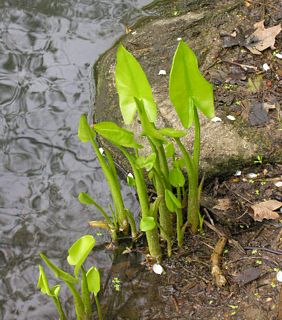
11: Jewelweed. Not much here.

12: Red bud. Buds edible now. At end of season.

13: Red bud.

14: Red bud.

15: Sheep sorrel flowers.

16: Sheep sorrel leaves. Leaves are in shape of sheep's head.

17: Blueberry flowers.

18: A patch of may apples.

19: A may apple fruit hangs under the leaves. Can only eat the fruit when it is yellow.

20: A may apple flower closeup.

21: False solomon seal. Flower's are on top. Now out of season. Only in April. The berries are edible, but bitter. It is called false as it has none of the medicinal properties of the eastern solomon seal.

22: View of Central Park Lake. The buildings are along Central Park South.

23: Curly dock. Stem really good now. Also called yellow dock. Best if cooked 2-3 minutes

24: Curly dock. A leaf closeup.

25: Gill-over-the-ground, or ground ivy. Make tea with it. Member of the mint family.

26: Gill-over-the-ground, or ground ivy.

27: Chickweed. Leaves in twos.

28: Common plantain.

29: Mulberry tree. In another month there will be berries.

30: Jet berry. Poisonous.

31: Common Violet.

32: Spicebush. You don't eat. Makes tea. Native Americans used it for fever.

33: Spicebush. Leaves closeup.

34: Northern wild raisin. Flowers closeup.

35: Northern wild raisin.

36: Witch hazel.
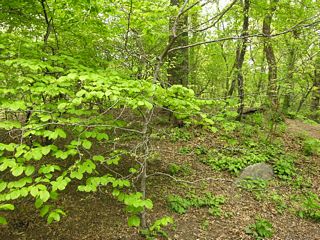
37: Cormorants. They swim under water.

38: Shepherd's purse. Flowers closeup.

39: Shepherd's purse. The bottom.

40: Shepherd's purse. The whole thing. A bit hard to photograph.

41: Horse chestnut. Inedible. Can make tincture.

42: Garlic mustard.

43: Garlic mustard. Flower closeup. Flowers have four petals in shape of a cross.

44: Virginia knotweed. We passed some again.

45: Burdock.

46: Burdock root closeup.

47: Burdock. See white fuzziness on bottom of leaf.

48: Two burdock roots someone dug up.

49: A large patch of second year garlic mustard that we passed. Can return for seeds in the summer.

50: Kentucky coffee tree. No leaves yet.

51: Kentucky coffee tree seed pod that I opened.

52: A young Kentucky coffee tree nearby.

53: Ground ivy again.

54: Blackberry.

55: Blackberry stem closeup. Stem has flat surfaces.

56: Bitter dock. Not poisonous, but no good to eat.

57: Bitter dock leaf closeup. Note no white fuzzy on leaf underside.

58: Sweet cherry. A European commercial variety. A bird must have brought it here. Started close to a crab apple, so it didn't get mowed.

59: Violets. Can eat flowers and leaves. Good now. Too bitter in June. Root inedible. It will make you vomit.

60: Field garlic.
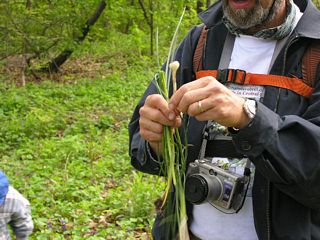
61: Field garlic in situ.
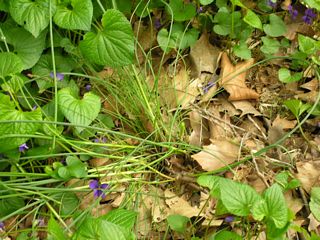
62: Field garlic in situ.

63: Field garlic bulb closeup.

64: White violets. Tastes the same as blues, but not as common.

65: Pokeweed. Must not get root.
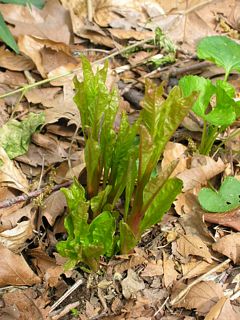
66: Pokeweed. Wildman explains that it is very good, but difficult to cook. Chop up and cook in boiling water and keep changing the water.

67: Pokeweed with some dead stalks from last year.

68: Poison ivy in amongst the violets.

69: Sassafras.

70: Sassafras.

© Don Wiss 2005-2024. All rights reserved.








